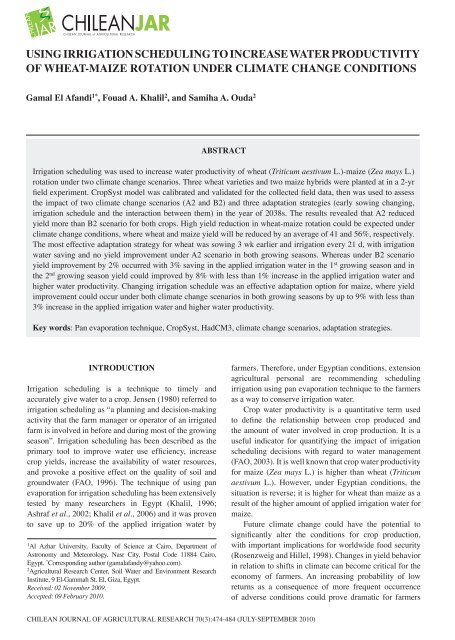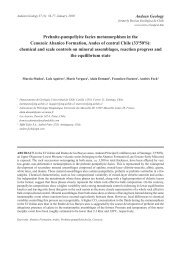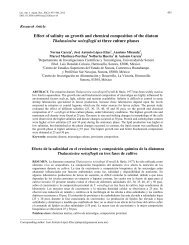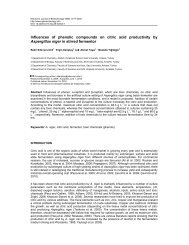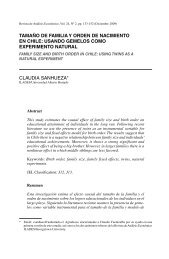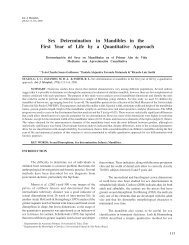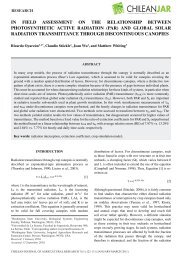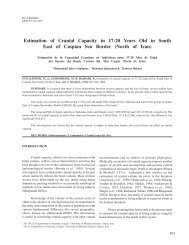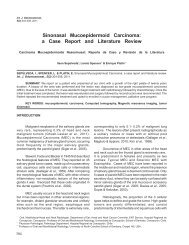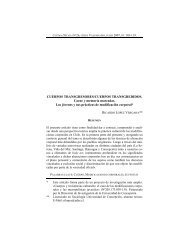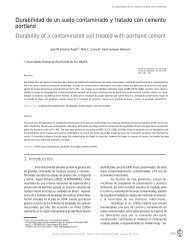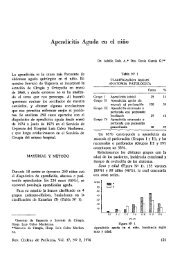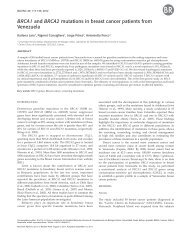using irrigation scheduling to increase water productivity of wheat ...
using irrigation scheduling to increase water productivity of wheat ...
using irrigation scheduling to increase water productivity of wheat ...
Create successful ePaper yourself
Turn your PDF publications into a flip-book with our unique Google optimized e-Paper software.
RESEARCH<br />
474 CHIL. J. AGR. RES. - VOL. 70 - Nº 3 - 2010<br />
USING IRRIGATION SCHEDULING TO INCREASE WATER PRODUCTIVITY<br />
OF WHEAT-MAIZE ROTATION UNDER CLIMATE CHANGE CONDITIONS<br />
Gamal El Afandi 1* , Fouad A. Khalil 2 , and Samiha A. Ouda 2<br />
ABSTRACT<br />
Irrigation <strong>scheduling</strong> was used <strong>to</strong> <strong>increase</strong> <strong>water</strong> <strong>productivity</strong> <strong>of</strong> <strong>wheat</strong> (Triticum aestivum L.)-maize (Zea mays L.)<br />
rotation under two climate change scenarios. Three <strong>wheat</strong> varieties and two maize hybrids were planted at in a 2-yr<br />
field experiment. CropSyst model was calibrated and validated for the collected field data, then was used <strong>to</strong> assess<br />
the impact <strong>of</strong> two climate change scenarios (A2 and B2) and three adaptation strategies (early sowing changing,<br />
<strong>irrigation</strong> schedule and the interaction between them) in the year <strong>of</strong> 2038s. The results revealed that A2 reduced<br />
yield more than B2 scenario for both crops. High yield reduction in <strong>wheat</strong>-maize rotation could be expected under<br />
climate change conditions, where <strong>wheat</strong> and maize yield will be reduced by an average <strong>of</strong> 41 and 56%, respectively.<br />
The most effective adaptation strategy for <strong>wheat</strong> was sowing 3 wk earlier and <strong>irrigation</strong> every 21 d, with <strong>irrigation</strong><br />
<strong>water</strong> saving and no yield improvement under A2 scenario in both growing seasons. Whereas under B2 scenario<br />
yield improvement by 2% occurred with 3% saving in the applied <strong>irrigation</strong> <strong>water</strong> in the 1 st growing season and in<br />
the 2 nd growing season yield could improved by 8% with less than 1% <strong>increase</strong> in the applied <strong>irrigation</strong> <strong>water</strong> and<br />
higher <strong>water</strong> <strong>productivity</strong>. Changing <strong>irrigation</strong> schedule was an effective adaptation option for maize, where yield<br />
improvement could occur under both climate change scenarios in both growing seasons by up <strong>to</strong> 9% with less than<br />
3% <strong>increase</strong> in the applied <strong>irrigation</strong> <strong>water</strong> and higher <strong>water</strong> <strong>productivity</strong>.<br />
Key words: Pan evaporation technique, CropSyst, HadCM3, climate change scenarios, adaptation strategies.<br />
INTRODUCTION<br />
Irrigation <strong>scheduling</strong> is a technique <strong>to</strong> timely and<br />
accurately give <strong>water</strong> <strong>to</strong> a crop. Jensen (1980) referred <strong>to</strong><br />
<strong>irrigation</strong> <strong>scheduling</strong> as “a planning and decision-making<br />
activity that the farm manager or opera<strong>to</strong>r <strong>of</strong> an irrigated<br />
farm is involved in before and during most <strong>of</strong> the growing<br />
season”. Irrigation <strong>scheduling</strong> has been described as the<br />
primary <strong>to</strong>ol <strong>to</strong> improve <strong>water</strong> use efficiency, <strong>increase</strong><br />
crop yields, <strong>increase</strong> the availability <strong>of</strong> <strong>water</strong> resources,<br />
and provoke a positive effect on the quality <strong>of</strong> soil and<br />
ground<strong>water</strong> (FAO, 1996). The technique <strong>of</strong> <strong>using</strong> pan<br />
evaporation for <strong>irrigation</strong> <strong>scheduling</strong> has been extensively<br />
tested by many researchers in Egypt (Khalil, 1996;<br />
Ashraf et al., 2002; Khalil et al., 2006) and it was proven<br />
<strong>to</strong> save up <strong>to</strong> 20% <strong>of</strong> the applied <strong>irrigation</strong> <strong>water</strong> by<br />
1<br />
Al Azhar University, Faculty <strong>of</strong> Science at Cairo, Department <strong>of</strong><br />
Astronomy and Meteorology, Nasr City, Postal Code 11884 Cairo,<br />
Egypt. * Corresponding author (gamalafandy@yahoo.com).<br />
2<br />
Agricultural Research Center, Soil Water and Environment Research<br />
Institute, 9 El-Gammah St. El, Giza, Egypt.<br />
Received: 02 November 2009.<br />
Accepted: 09 February 2010.<br />
farmers. Therefore, under Egyptian conditions, extension<br />
agricultural personal are recommending <strong>scheduling</strong><br />
<strong>irrigation</strong> <strong>using</strong> pan evaporation technique <strong>to</strong> the farmers<br />
as a way <strong>to</strong> conserve <strong>irrigation</strong> <strong>water</strong>.<br />
Crop <strong>water</strong> <strong>productivity</strong> is a quantitative term used<br />
<strong>to</strong> define the relationship between crop produced and<br />
the amount <strong>of</strong> <strong>water</strong> involved in crop production. It is a<br />
useful indica<strong>to</strong>r for quantifying the impact <strong>of</strong> <strong>irrigation</strong><br />
<strong>scheduling</strong> decisions with regard <strong>to</strong> <strong>water</strong> management<br />
(FAO, 2003). It is well known that crop <strong>water</strong> <strong>productivity</strong><br />
for maize (Zea mays L.) is higher than <strong>wheat</strong> (Triticum<br />
aestivum L.). However, under Egyptian conditions, the<br />
situation is reverse; it is higher for <strong>wheat</strong> than maize as a<br />
result <strong>of</strong> the higher amount <strong>of</strong> applied <strong>irrigation</strong> <strong>water</strong> for<br />
maize.<br />
Future climate change could have the potential <strong>to</strong><br />
significantly alter the conditions for crop production,<br />
with important implications for worldwide food security<br />
(Rosenzweig and Hillel, 1998). Changes in yield behavior<br />
in relation <strong>to</strong> shifts in climate can become critical for the<br />
economy <strong>of</strong> farmers. An increasing probability <strong>of</strong> low<br />
returns as a consequence <strong>of</strong> more frequent occurrence<br />
<strong>of</strong> adverse conditions could prove dramatic for farmers<br />
CHILEAN JOURNAL OF AGRICULTURAL RESEARCH 70(3):474-484 (JULY-SEPTEMBER 2010)
G. EL AFANDI et al. - USING IRRIGATION SCHEDULING TO INCREASE WATER…<br />
475<br />
operating at the limit <strong>of</strong> economic stress (Torriani et al.,<br />
2007b). Therefore, climate change urgently needs <strong>to</strong> be<br />
assessed at the farm level, so that poor and vulnerable<br />
farmers dependent on agriculture can be appropriately<br />
targeted in research and development activities on<br />
poverty alleviation (Jones and Thorn<strong>to</strong>n, 2003). Assessing<br />
the possible impact <strong>of</strong> climate change on production<br />
risks is therefore necessary <strong>to</strong> help decision makers and<br />
stakeholders identify and implement suitable measures <strong>of</strong><br />
adaptation (Torriani et al., 2007b).<br />
Wheat-maize rotation is a favorite one by the Egyptian<br />
farmers due <strong>to</strong> its high pr<strong>of</strong>itability in Middle Egypt.<br />
Under climate change conditions, both <strong>wheat</strong> and maize<br />
production could be adversely affected by heat stress<br />
resulting from climate change conditions. Regarding <strong>to</strong><br />
<strong>wheat</strong>, numbers <strong>of</strong> tillers are usually decreased when<br />
<strong>wheat</strong> plants were exposed <strong>to</strong> high temperature (Friend,<br />
1965). Furthermore, high temperature during anthesis<br />
causes pollen sterility (Saini and Aspinall, 1982) and<br />
reduces number <strong>of</strong> kernels per head, if it prevailed during<br />
early spike development (Kolderup, 1979). The duration<br />
<strong>of</strong> grain filling period could be reduced under high<br />
temperature (S<strong>of</strong>ield et al., 1977), as well as growth rates<br />
with a net effect <strong>of</strong> lower final kernel weight (Bagga and<br />
Rawson, 1977; McMaster, 1997).<br />
Similarly, heat stress could accelerate the rate <strong>of</strong> maize<br />
plant growth (Ritchie et al., 1993) and consequently<br />
reduce growing season length. High temperature can<br />
reduce kernel sink capacity and limit subsequent kernel<br />
development and final maize yield (Cheikh and Jones,<br />
1994). It has been suggested that each 1 ºC <strong>increase</strong> in<br />
temperature above optimum could result in a reduction<br />
<strong>of</strong> 3 <strong>to</strong> 4% in grain yield (Shaw, 1983). During the early<br />
stage <strong>of</strong> kernel development, heat stress is particularly<br />
detrimental <strong>to</strong> subsequent dry matter accumulation,<br />
because it disrupts cell division, sugar metabolism, and<br />
starch biosynthesis in the endosperm (Monjardino et al.,<br />
2005).<br />
Thus, it is expected that climate change will have<br />
implications for possible fluctuation on <strong>wheat</strong> yield<br />
(Wrigley, 2006) and maize yield (Díaz-Ambrona et al.,<br />
2004). Previous research in Egypt predicted reduction in<br />
the national <strong>wheat</strong> production by up <strong>to</strong> 30% and <strong>increase</strong><br />
in its <strong>water</strong> needs by up <strong>to</strong> 3% (Eid et al., 1992; 1993;<br />
1994) by 2050. Furthermore, national maize production<br />
will decrease by 25% in 2050 as it was projected <strong>using</strong><br />
GCMs or MAGICSENGEN scenarios (Eid et al., 1992;<br />
1997; Eid and El-Mowelhi, 1998).<br />
Using process-based models <strong>of</strong> crop growth, such as<br />
CropSyst (S<strong>to</strong>ckle et al., 1994) along with a set <strong>of</strong> daily<br />
weather data spanning a reasonable number <strong>of</strong> years<br />
could be a suitable solution <strong>to</strong> assess the impact <strong>of</strong> climate<br />
change on agriculture (Tubiello et al., 2000; Torriani et<br />
al., 2007a). The application <strong>of</strong> such models allows the<br />
simulation <strong>of</strong> many possible climate change scenarios<br />
from only a few experiments for calibration. Furthermore,<br />
the effect <strong>of</strong> <strong>using</strong> different adaptation strategies on the<br />
yield <strong>of</strong> the simulated crops could also be assessed <strong>to</strong><br />
determine its efficacy in improving yield under climate<br />
change conditions.<br />
The objectives <strong>of</strong> this research were (i) <strong>to</strong> use<br />
CropSyst model <strong>to</strong> assess the impact <strong>of</strong> two climate<br />
change scenarios on the yield and consumptive <strong>water</strong><br />
use <strong>of</strong> <strong>wheat</strong> and maize crops; (ii) <strong>to</strong> use the model <strong>to</strong><br />
determine the efficiency <strong>of</strong> the proposed adaptation<br />
strategies in improving the yield and <strong>water</strong> <strong>productivity</strong><br />
<strong>of</strong> the two crops under climate change scenarios.<br />
MATERIALS AND METHODS<br />
Field experiments<br />
Two-year field experiment for <strong>wheat</strong> and maize were<br />
conducted at Giza Agricultural Research Station (31°13’<br />
S, 30°02’ E, 22.5 m.a.s.l.), middle Egypt. Wheat (a winter<br />
crop) was planted in 2006/2007 and 2007/2008 growing<br />
seasons and maize (a summer crop) was planted in<br />
2007 and 2008 growing seasons. Surface <strong>irrigation</strong> was<br />
used. Irrigation was applied <strong>using</strong> 1.2 pan evaporation<br />
coefficient, which is the optimum for <strong>wheat</strong> and maize<br />
under Giza climatic conditions. Evaporation data were<br />
collected on a daily basis from a standard Class-A-Pan<br />
located near the experimental field. Irrigation amounts<br />
were calculated for both crops with the following equation<br />
(Allen et al., 1998):<br />
I = Epan Kp [1]<br />
where I is the applied <strong>irrigation</strong> <strong>water</strong> (mm), Epan is<br />
the cumulative evaporation in the period <strong>of</strong> <strong>irrigation</strong><br />
interval (mm), Kp is the pan evaporation coefficient.<br />
Actual evapotranspiration for both crops was estimated<br />
by the soil sampling method and calculated according<br />
<strong>to</strong> the method <strong>of</strong> Israelsen and Hansen (1962) <strong>using</strong> the<br />
following formula:<br />
CU = (θ 2 - θ 1) Bd ERZ [2]<br />
where CU is the amount <strong>of</strong> consumptive <strong>water</strong> use (mm),<br />
θ 2 is soil moisture percentage after <strong>irrigation</strong>, θ 1 is soil<br />
moisture percentage before the following <strong>irrigation</strong>, Bd is<br />
bulk density (g cm -3 ) and ERZ is the effective root zone.<br />
The measured soil moisture constants (% per weight) and<br />
bulk density (g cm -3 ) in the depth <strong>of</strong> 0-60 cm are shown<br />
in Table 1.<br />
Maximum leaf area index (at anthesis) was measured<br />
for both crops. Degree days from planting <strong>to</strong> anthesis and<br />
physiological maturity were calculated. At harvest, grain<br />
and biological yield <strong>of</strong> the two crops were measured and<br />
harvest index was calculated. Consumptive <strong>water</strong> use <strong>of</strong><br />
<strong>water</strong> for both crops was determined.
476 CHIL. J. AGR. RES. - VOL. 70 - Nº 3 - 2010<br />
Table 1. Soil moisture constants <strong>of</strong> the experimental field at Giza Agricultural Station.<br />
Deph Field capacity<br />
Wilting point Available <strong>water</strong> Bulk density<br />
cm % (w/w) % (w/w) mm g cm -3<br />
0-15 41.9 18.6 40.0 1.2<br />
15-30 33.7 17.5 30.1 1.2<br />
30-45 28.4 16.9 20.6 1.2<br />
45-60 28.1 16.5 22.1 1.3<br />
Wheat<br />
Three <strong>wheat</strong> varieties were planted, Sids 1, Sakha 93 and<br />
Giza 168, in a randomized complete block design with three<br />
replicates. Wheat was planted on the 15 and 17 November<br />
in the first and second growing seasons, respectively.<br />
Nitrogen fertilizer in the form <strong>of</strong> urea (180 kg ha -1 , 46%<br />
N) was applied before the second <strong>irrigation</strong>. Phosphorus<br />
fertilizer was applied in the form <strong>of</strong> single super phosphate<br />
(36 kg ha -1 , 15% P 2O 5) and was incorporated in<strong>to</strong> the<br />
soil during land preparation. Potassium in the form <strong>of</strong><br />
potassium sulfate (57 kg ha -1 , 48% K 2O) was applied at<br />
booting stage. The applied amount <strong>of</strong> NPK fertilizer was<br />
sufficient <strong>to</strong> ensure optimum growth. Second <strong>irrigation</strong><br />
was applied 30 d after planting then <strong>irrigation</strong> was<br />
applied every 21-23 d with a <strong>to</strong>tal <strong>of</strong> seven <strong>irrigation</strong>s.<br />
Harvest was done in the 3 rd week <strong>of</strong> April in both growing<br />
seasons.<br />
Maize<br />
Two maize hybrids (TWC 310 and TWC 324) were<br />
planted in a randomized complete block design with three<br />
replicates. Sowing was done on the 19 and 21 June in the<br />
1 st and 2 nd growing season, respectively. Nitrogen fertilizer<br />
in the form <strong>of</strong> urea (288 kg ha -1 , 46% N) was applied before<br />
2 nd <strong>irrigation</strong>. Phosphorus fertilizer was applied in the form<br />
<strong>of</strong> single super phosphate (47 kg ha -1 , 15.5% P 2O 5) and<br />
was incorporated in<strong>to</strong> the soil during land preparation.<br />
Potassium sulfate was applied before planting (120 kg<br />
ha -1 , 48% K 2O). The second <strong>irrigation</strong> was applied around<br />
22 d after planting, then <strong>irrigation</strong> was applied every 14-15<br />
d in both growing seasons with a <strong>to</strong>tal <strong>of</strong> seven <strong>irrigation</strong>s.<br />
Harvest was done in the second week <strong>of</strong> Oc<strong>to</strong>ber in both<br />
growing seasons.<br />
CropSyst Model<br />
CropSyst (Cropping Systems Simulation Model) is<br />
a multi-year, multi-crop, daily time step crop growth<br />
simulation model, developed with emphasis on a friendly<br />
user interface, and with a link <strong>to</strong> GIS (Geographic<br />
Information System) s<strong>of</strong>tware and a weather genera<strong>to</strong>r<br />
(S<strong>to</strong>ckle et al., 1994). The model’s objective is <strong>to</strong> serve<br />
as an analytical <strong>to</strong>ol <strong>to</strong> study the effect <strong>of</strong> cropping<br />
systems management on crop <strong>productivity</strong> and the<br />
environment. For this purpose, CropSyst simulates the<br />
soil <strong>water</strong> budget, soil-plant N budget, crop phenology,<br />
crop canopy and root growth, biomass production,<br />
crop yield, residue production and decomposition, soil<br />
erosion by <strong>water</strong>, and pesticide fate. These parameters<br />
are affected by weather, soil and crop characteristics, and<br />
cropping system management options. Cropping system<br />
management includes crop rotation, variety selection,<br />
<strong>irrigation</strong>, N fertilization, pesticide applications, soil and<br />
<strong>irrigation</strong> <strong>water</strong> salinity, tillage operations, and residue<br />
management.<br />
CropSyst model calibration and validation<br />
In order <strong>to</strong> assess the impact <strong>of</strong> climate change on <strong>wheat</strong><br />
and maize, CropSyst model was calibrated and validated<br />
<strong>using</strong> the collected field data for each crop separately.<br />
Then the model was run <strong>using</strong> the developed climate<br />
change scenarios. For each crop and after each growing<br />
season, input files required by CropSyst model for Giza<br />
location and <strong>wheat</strong> and maize crops were prepared and<br />
use <strong>to</strong> run the model. Maximum leaf area index (LAI),<br />
degree day <strong>to</strong> anthesis and physiological maturity,<br />
and harvest index were used <strong>to</strong> calibrate the model for<br />
each crop. A few variety-specific parameters were also<br />
calibrated within a reasonable range <strong>of</strong> fluctuation sets in<br />
CropSyst manual. These variety-specific parameters were:<br />
aboveground biomass-transpiration coefficient and light<br />
<strong>to</strong> above ground biomass conversion. After calibration,<br />
the model was validated <strong>using</strong> the measured data <strong>of</strong> yield<br />
and consumptive <strong>water</strong> use for the two crops. To test the<br />
goodness <strong>of</strong> fit between the measured and predicted data,<br />
percent difference between measured and predicted values<br />
for each variety in each growing season were calculated,<br />
in addition <strong>to</strong> root mean squared error (Jamieson et al.,<br />
1998) and Willmott index <strong>of</strong> agreement (Willmott, 1981).<br />
Climate change scenarios<br />
In this work, the HadCM3 which is a coupled atmosphereocean<br />
general circulation model (AOGCM) developed at<br />
the Hadley Centre for Climate Prediction and Research<br />
(United Kingdom) was used (Gordon et al., 2000; Pope<br />
et al., 2000) and considered as significantly and more<br />
sophisticated than earlier versions (Hulme and Jenkins
G. EL AFANDI et al. - USING IRRIGATION SCHEDULING TO INCREASE WATER…<br />
477<br />
1998). This model has a spatial resolution <strong>of</strong> 2.50 x 3.75<br />
(latitude by longitude). HadCM3 provide information<br />
about climate change over the entire world during the 21 st<br />
century and present information about three times slices:<br />
2020s, 2050s, and 2080s. In order <strong>to</strong> provide information<br />
on possible changes in the world climate, the climate<br />
change models are forced <strong>to</strong> consider future scenarios.<br />
The IPCC (Nakicenovic et al., 2000) has developed<br />
emission scenarios known as Special Report on Emission<br />
Scenarios (SRES). The four SRES scenarios combined<br />
two sets <strong>of</strong> divergent tendencies: one set varying between<br />
strong economic values and strong environmental<br />
values, the other set between increasing globalization<br />
and increasing regionalization (IPCC-TGCIA, 1999).<br />
Two climate change scenarios were considered in this<br />
study: A2 and B2. These selected two scenarios consider<br />
a rise in global mean temperature by 3.09 and 2.16 °C,<br />
respectively, CO 2 concentration will be 834 and 601 ppm,<br />
respectively and global mean sea level will rise by 62<br />
and 52 cm, respectively. As the resolution <strong>of</strong> the model<br />
is <strong>to</strong>o big, <strong>using</strong> simple interpolation techniques <strong>of</strong> these<br />
percentages have been applied <strong>to</strong> fit the station site. Data<br />
were downloaded in GRIB format (Gridded Binary, is<br />
an international, public, binary format for the efficient<br />
s<strong>to</strong>rage <strong>of</strong> meteorological/oceanographic variables) from<br />
the Intergovernmental Panel on Climate Change (IPCC)<br />
Data Distribution Centre Web site.<br />
The GRBCONV program was used <strong>to</strong> convert the data<br />
files from GRIB format <strong>to</strong> the more conventional ASCII<br />
(American Standard Code for Information Interchange).<br />
The download site does not <strong>of</strong>fer the option <strong>to</strong> subset the<br />
data based on an area <strong>of</strong> interest, so a cus<strong>to</strong>m program<br />
was used <strong>to</strong> extract the data for the region <strong>of</strong> interest.<br />
HadCM3 model (Hadley Centre for Climate Prediction<br />
and Research, UK) variables were monthly precipitation,<br />
solar radiation, minimum and maximum temperatures.<br />
A2 and B2 climate change scenarios were used <strong>to</strong><br />
run the CropSyst model <strong>to</strong> predict <strong>wheat</strong> and maize yield<br />
and consumptive <strong>water</strong> use in the year <strong>of</strong> 2038s. The<br />
reason for choosing that year was <strong>to</strong> perceive how the<br />
<strong>productivity</strong> <strong>of</strong> each crop on a farm level will be affected<br />
after 30 yr. The effect <strong>of</strong> each climate change scenario on<br />
the 1 st and the 2 nd season will be discussed separately as if<br />
each case could be a representation <strong>of</strong> the growing season<br />
<strong>of</strong> the year 2038s.<br />
The simplest method <strong>of</strong> downscaling is <strong>to</strong> interpolate<br />
the change fields <strong>to</strong> the site or region <strong>of</strong> interest by <strong>using</strong><br />
Cartesian geometry and geostatistics.<br />
Adaptation strategies<br />
Three adaptation strategies were considered for each<br />
crop: early sowing, changing <strong>irrigation</strong> schedule and<br />
the effect <strong>of</strong> the interaction between early sowing and<br />
changing <strong>irrigation</strong> schedule. Under the new <strong>irrigation</strong><br />
schedule, the model was adjusted <strong>to</strong> supply enough<br />
<strong>water</strong> <strong>to</strong> fill root zone area with available plant <strong>water</strong><br />
whenever each single <strong>irrigation</strong>, was applied. This<br />
adjustment guaranteed that the growing plants will<br />
not experience <strong>water</strong> stress but heat stress under the<br />
proposed climate change scenarios. The effect <strong>of</strong> these<br />
adaptation strategies on the yield <strong>of</strong> the two crops<br />
and on the required <strong>irrigation</strong> amount was compared<br />
with respect <strong>to</strong> percent <strong>of</strong> yield improvement, percent<br />
<strong>increase</strong> in <strong>irrigation</strong> <strong>water</strong> and crop <strong>water</strong> <strong>productivity</strong>.<br />
Efficient adaptation strategy is the one that <strong>increase</strong><br />
percent <strong>of</strong> yield improvement, reduce percent <strong>increase</strong><br />
in <strong>irrigation</strong> <strong>water</strong> and <strong>increase</strong> crop <strong>water</strong> <strong>productivity</strong><br />
under the tested climate change scenarios.<br />
Wheat<br />
The effect <strong>of</strong> sowing <strong>wheat</strong> 3 wk earlier, on 21 Oc<strong>to</strong>ber<br />
instead <strong>of</strong> sowing on 15 November was proposed.<br />
Changing the original <strong>irrigation</strong> schedule was done by<br />
simulating the effect <strong>of</strong> <strong>irrigation</strong> in a constant interval<br />
every 21 d on <strong>wheat</strong> yield, which resulted in applying a<br />
<strong>to</strong>tal <strong>of</strong> eight <strong>irrigation</strong>s.<br />
Maize<br />
Early sowing by 3 wk was also proposed for maize as an<br />
adaptation option. Furthermore, <strong>irrigation</strong> every 14 d with<br />
a <strong>to</strong>tal <strong>of</strong> seven <strong>irrigation</strong>s was also proposed instead <strong>of</strong><br />
the original <strong>irrigation</strong> schedule.<br />
RESULTS AND DISCUSSION<br />
CropSyst model calibration and validation<br />
Wheat. Results show that CropSyst model predicted<br />
<strong>wheat</strong> yield with high degree <strong>of</strong> accuracy (Table 2). Percent<br />
difference between measured and predicted <strong>wheat</strong> yield<br />
was less than 1%. Root mean squared error (RMSE) was<br />
0.0157 t ha -1 and Willmott index <strong>of</strong> agreement was 0.99.<br />
Singh et al. (2008) indicated that CropSyst model is more<br />
appropriate than CERES-Wheat in predicting growth and<br />
yield <strong>of</strong> <strong>wheat</strong> under different N and <strong>irrigation</strong> application<br />
situations, where RMSE was 0.36 t ha -1 compared with<br />
0.63 t ha -1 for CERES-Wheat. Whereas, Lobell and Ortiz-<br />
Monasterio (2006) stated that CERES-Wheat model was<br />
able <strong>to</strong> predict <strong>wheat</strong> yield for different <strong>irrigation</strong> trials<br />
quite well with a RMSE <strong>of</strong> 0.23 t ha -1 .<br />
Regarding <strong>to</strong> consumptive <strong>water</strong> use, the model<br />
prediction was highly accurate <strong>to</strong>o. Percent difference<br />
between measured and predicted <strong>wheat</strong> consumptive<br />
<strong>water</strong> use was less than 1%. RMSE was 0.5692 mm and<br />
Willmott index <strong>of</strong> agreement was 0.9999 (Table 2). Similar<br />
results were obtained by Wang et al. (2006), where RMSE<br />
was 0.07 mm for evapotranspiration and Pannkuk et al.
478 CHIL. J. AGR. RES. - VOL. 70 - Nº 3 - 2010<br />
Table 2. Measured versus predicted <strong>wheat</strong> yield and consumptive <strong>water</strong> use in the two growing seasons.<br />
Growing<br />
season<br />
Variety<br />
Wheat yield<br />
Consumptive <strong>water</strong> use<br />
Measured Predicted PD Measured Predicted PD<br />
t ha -1 % mm %<br />
2006/2007 Sids 1 5.92 5.91 0.20 380.95 379.80 0.30<br />
Sakha 93 5.86 5.82 0.64 362.86 361.88 0.27<br />
Giza 168 5.52 5.51 0.16 358.10 355.64 0.69<br />
2007/2008 Sids 1 5.40 5.39 0.19 400.95 400.82 0.03<br />
Sakha 93 5.39 5.36 0.61 366.90 366.09 0.22<br />
Giza 168 5.38 5.38 0 367.14 365.64 0.41<br />
RMSE 0.0157 0.5692<br />
WI 0.9999 0.9999<br />
PD%: percent difference between measured and predicted values; RMSE: root mean squared error; WI: Willmott index <strong>of</strong> agreement.<br />
(1998), where it was 0.05 mm when CropSyst was used <strong>to</strong><br />
predict evapotranspiration.<br />
Maize. CropSyst model predicted maize yield and<br />
consumptive <strong>water</strong> use with high degree <strong>of</strong> accuracy.<br />
Percent difference between measured and predicted<br />
values was less than 1% for both yield and consumptive<br />
<strong>water</strong> use. Willmott index <strong>of</strong> agreement was the highest<br />
and RMSE was very low (Table 3). Díaz-Ambrona et<br />
al. (2004) stated that the simulations <strong>of</strong> maize yield by<br />
CropSyst were close <strong>to</strong> measured values, where RMSE<br />
was 1.2 t ha -1 . These results are in agreement with what<br />
was found by Riving<strong>to</strong>n et al. (2007), Moriondo et al.<br />
(2007) and Tingem et al. (2007), where they stated that<br />
CropSyst is recognized by its robustness and relatively<br />
easy applicability with commonly available information.<br />
The accurate results obtained from running the model<br />
for the two crops under both growing seasons implied<br />
that the model can be used in simulating <strong>wheat</strong> and maize<br />
yield under any other situation. Although the above<br />
situation provides only a limited evaluation <strong>of</strong> the model,<br />
the model should be further tested as more data from<br />
more treatments in different locations and years become<br />
available. However, for the purposes <strong>of</strong> this study we are<br />
confident in that the model worked sufficiently well <strong>to</strong><br />
warrant the exploration <strong>of</strong> the effect <strong>of</strong> climate change on<br />
<strong>wheat</strong> and maize yield and <strong>water</strong> requirements.<br />
Effect <strong>of</strong> climate change scenarios on yield and<br />
consumptive <strong>water</strong> use<br />
Excessive losses in both <strong>wheat</strong> and maize yield could<br />
occur under both climate change scenarios and high<br />
<strong>increase</strong> in consumptive <strong>water</strong> use would be expected <strong>to</strong>o<br />
in the year <strong>of</strong> 2038s (Table 4). These yield losses could be<br />
as high as 47 and 54% for <strong>wheat</strong> and maize, respectively.<br />
Consumptive <strong>water</strong> use could be elevated by 7.14 and<br />
19.95% for <strong>wheat</strong> and maize, respectively. Furthermore,<br />
<strong>wheat</strong> var. Sakha 93 (V2) and maize hybrid TWC324 (V2)<br />
were found <strong>to</strong> be more <strong>to</strong>lerant <strong>to</strong> heat stress, compared<br />
with the rest <strong>of</strong> the varieties. That <strong>to</strong>lerance was expressed<br />
in lower yield reduction values under both climate change<br />
scenarios (Table 4).<br />
Similar trend was observed for both crops in the<br />
second season, where the lowest yield reduction could<br />
Table 3. Measured versus predicted maize yield and consumptive <strong>water</strong> use in the two growing seasons.<br />
Growing<br />
season<br />
Hybrid<br />
Maize yield<br />
Consumptive <strong>water</strong> use<br />
Measured Predicted PD Measured Predicted PD<br />
t ha -1 % mm %<br />
2007 TWC310 5.71 5.70 0.17 545.70 542.82 0.53<br />
TWC324 5.41 5.42 0.18 531.00 530.59 0.08<br />
2008 TWC310 5.92 5.89 0.51 540.60 539.14 0.27<br />
TWC324 5.79 5.78 0.17 525.00 524.02 0.19<br />
RMSE 0.0087 0.0092<br />
WI 0.9999 0.9999<br />
PD%: percent difference between measured and predicted values; RMSE: root mean squared error; WI: Willmott index <strong>of</strong> agreement.
G. EL AFANDI et al. - USING IRRIGATION SCHEDULING TO INCREASE WATER…<br />
479<br />
Table 4. Percent change in yield and consumptive <strong>water</strong> use <strong>of</strong> <strong>wheat</strong> and maize under climate change scenarios in the<br />
first season.<br />
Wheat<br />
Maize<br />
Variety<br />
Climate<br />
Scenario Yield PR CU PI Yield PR CU PI<br />
t ha -1 % mm % t ha -1 % mm %<br />
V1 Current 5.91 NP 379.80 NP 5.70 NP 542.82 NP<br />
A2 3.20 46 398.94 5 2.61 54 605.75 12<br />
B2 3.61 39 402.81 6 3.35 41 651.13 20<br />
V2 Current 5.82 NP 361.88 NP 5.42 NP 530.42 NP<br />
A2 3.22 45 386.31 7 2.55 53 597.9 13<br />
B2 3.63 38 387.71 7 3.27 40 625.94 18<br />
V3 Current 5.51 NP 355.64 NP NP NP NP NP<br />
A2 2.90 47 375.65 6 NP NP NP NP<br />
B2 3.32 40 375.8 6 NP NP NP NP<br />
V1: <strong>wheat</strong> var. Sids 1 or maize hybrid TWC310; V2: <strong>wheat</strong> var. Sakha 93 or maize hybrid TWC324; V3: <strong>wheat</strong> var. Giza 168; PR%: percent reduction<br />
between measured and predicted yield; NP: not applicable; CU: consumptive <strong>water</strong> use; PI%: percent <strong>increase</strong> between measured and predicted<br />
consumptive <strong>water</strong> use; A2 and B2: two climate change scenarios.<br />
occur for <strong>wheat</strong> var. Sakha 93 and maize hybrid TWC324<br />
as a result <strong>of</strong> being more <strong>to</strong>lerant <strong>to</strong> heat stress (Table 5).<br />
Therefore, the analysis will focus on these two varieties.<br />
Furthermore, the results also showed that, under both<br />
climate change scenarios, <strong>wheat</strong> yield reduction was<br />
lower in the second seasons for the three varieties,<br />
compared with the first season (Tables 4 and 5). However,<br />
the situation was different for maize, where higher yield<br />
reduction could exist in the second season, compared with<br />
the first one (Tables 4 and 5).<br />
Effect <strong>of</strong> adaptation strategies on crop <strong>water</strong><br />
<strong>productivity</strong><br />
Regarding <strong>to</strong> <strong>wheat</strong> planted in both seasons under<br />
A2 climate change scenario, the proposed adaptation<br />
strategies did not improved <strong>water</strong> <strong>productivity</strong>, however<br />
it could save <strong>irrigation</strong> <strong>water</strong> and it <strong>increase</strong> yield losses<br />
under either early sowing or early sowing and <strong>irrigation</strong><br />
every 21 d (Table 6). Early sowing and <strong>irrigation</strong> every 21<br />
d could save 3 and 1% <strong>of</strong> the applied <strong>irrigation</strong> <strong>water</strong> and<br />
reduced yield by 7 and 1% in the first and second seasons,<br />
respectively (Table 6).<br />
Regarding <strong>to</strong> maize grown under the same respective<br />
climate change scenario, <strong>irrigation</strong> every 14 d <strong>increase</strong>d<br />
<strong>water</strong> <strong>productivity</strong> in both seasons, with 3 and 1% <strong>increase</strong><br />
in applied <strong>irrigation</strong> <strong>water</strong> in both seasons, respectively,<br />
which reflected on yield improvement by 4.24 and 3.63%<br />
in both seasons, respectively (Table 6).<br />
Table 5. Percent change in yield and consumptive <strong>water</strong> use <strong>of</strong> <strong>wheat</strong> and maize under climate change scenarios in the<br />
second season.<br />
Wheat<br />
Maize<br />
Variety<br />
Climate<br />
scenario Yield PR CU PI Yield PR CU PI<br />
t ha -1 % mm % t ha -1 % mm %<br />
V1 Current 5.39 NP 400.82 NP 5.89 NP 539.14 NP<br />
A2 3.42 37 420.25 5 2.57 56 616.03 14<br />
B2 3.45 36 427.45 7 2.98 50 620.01 15<br />
V2 Current 5.36 NP 366.09 NP 5.78 NP 524.02 NP<br />
A2 3.41 36 388.22 6 2.63 55 597.90 14<br />
B2 3.47 35 389.05 6 3.04 47 580.48 11<br />
V3 Current 5.38 NP 365.64 NP NP NP NP NP<br />
A2 3.40 37 386.77 6 NP NP NP NP<br />
B2 3.47 36 386.88 6 NP NP NP NP<br />
V1: <strong>wheat</strong> var. Sids 1 or maize hybrid TWC310; V2: <strong>wheat</strong> var. Sakha 93 or maize hybrid TWC324; V3: <strong>wheat</strong> var. Giza 168; PR%: percent reduction<br />
between measured and predicted yield; NP: not applicable; CU: consumptive <strong>water</strong> use; PI%: percent <strong>increase</strong> between measured and predicted<br />
consumptive <strong>water</strong> use; A2 and B2: two climate change scenarios.
480 CHIL. J. AGR. RES. - VOL. 70 - Nº 3 - 2010<br />
Table 6. Percent change in yield and <strong>irrigation</strong> amounts for <strong>wheat</strong> and maize and corresponded <strong>water</strong> <strong>productivity</strong><br />
values in both seasons under A2 scenario.<br />
Wheat (Sakha 93)<br />
Maize (TWC324)<br />
Adaptation<br />
strategy<br />
Change in<br />
yield<br />
Change in<br />
<strong>irrigation</strong><br />
WP<br />
Change in<br />
yield<br />
Change in<br />
<strong>irrigation</strong><br />
WP<br />
% kg m -3<br />
% kg m -3<br />
2006/2007 NP NP 0.75 NP NP 0.32<br />
ES -10 -5 0.66 -9 +12 0.25<br />
I 0 +11 0.69 +4 +3 0.38<br />
ES x I -7 -3 0.69 0 +8 0.33<br />
2007/2008 NP NP 0.80 NP NP 0.43<br />
ES -5 -0.59 0.75 +2.42 +7 0.43<br />
I +2 +12.35 0.74 +3.63 +1 0.46<br />
ES x I -1 -1.19 0.80 +1.56 +2 0.44<br />
ES: sowing either <strong>wheat</strong> or maize 3 wk earlier; I: <strong>irrigation</strong> every 21 or 14 d for <strong>wheat</strong> or maize, respectively; NP: not applicable; ES x I: interaction<br />
between early sowing and <strong>irrigation</strong>; WP: <strong>water</strong> <strong>productivity</strong>.<br />
The situation was different for <strong>wheat</strong> under B2<br />
climate change scenario, where <strong>water</strong> <strong>productivity</strong> was<br />
<strong>increase</strong>d under sowing <strong>wheat</strong> 3 wk earlier and <strong>irrigation</strong><br />
was applied every 21 d in both seasons (Table 7). Under<br />
this scenario, both yield improvement and <strong>irrigation</strong><br />
<strong>water</strong> saving could occur. Results in Table 7 indicated that<br />
<strong>wheat</strong> yield could improve by 2% under saving 3% <strong>of</strong> the<br />
<strong>irrigation</strong> <strong>water</strong> in the first season. Whereas, in the second<br />
season, 8% improvement in <strong>wheat</strong> yield could happen<br />
with less than 1% <strong>increase</strong> in the applied <strong>irrigation</strong> <strong>water</strong>.<br />
Applying <strong>irrigation</strong> every 14 d for maize would be<br />
the appropriate adaptation option <strong>to</strong> be used <strong>to</strong> reduce<br />
yield losses and <strong>to</strong> <strong>increase</strong> <strong>water</strong> <strong>productivity</strong> under both<br />
seasons, especially in the second season, where maize<br />
yield was improved by 9%, with 1% <strong>increase</strong>d in the<br />
applied <strong>irrigation</strong> <strong>water</strong> (Table 7).<br />
Shifts in yield and yield stability largely depend<br />
on assumptions about future emissions, the climate<br />
projections, and the downscaling procedure used <strong>to</strong><br />
generate the climatic data at the regional scale typically<br />
required as input <strong>to</strong> crop models. Olesen et al. (2007)<br />
noted that for a site-based analysis the method used<br />
for downscaling is more crucial than the choice <strong>of</strong> a<br />
specific climate scenario. They also pointed out that<br />
the use <strong>of</strong> climate model outputs directly as input <strong>to</strong><br />
crop simulation model is appropriate. Thus, our results<br />
showed that the downscaling process <strong>of</strong> HadCM3<br />
model was appropriate <strong>to</strong> Egypt as it was shown by the<br />
statistical analysis.<br />
The results <strong>of</strong> the field experiments showed the<br />
climatic condition under which <strong>wheat</strong> grown was more<br />
stressful in the first growing season, compared with the<br />
second; expressed in lower yield in the second growing<br />
season (Table 2). That effect was also pronounced<br />
under both climate change scenarios, where <strong>wheat</strong> yield<br />
reduction was lower on in the second growing season<br />
(Table 4 and 5). The situation was reversed for maize<br />
yield, where it was higher in the second growing (Table<br />
3) and yield reduction was higher in the second growing<br />
season under climate change conditions (Table 4 and<br />
5). This result implied that CropSyst model was very<br />
successful in conveying the state <strong>of</strong> the growing <strong>wheat</strong><br />
and maize plants as it affected by the prevailing climatic<br />
conditions during each growing season, which reflected<br />
on the simulated yield under current climate and under<br />
climate change scenarios.<br />
Regional assessments <strong>of</strong> the effects <strong>of</strong> climate change<br />
on crop production are needed at various decision levels,<br />
and they are necessary <strong>to</strong> quantify the economic impacts<br />
at the farm and regional scale. Our results implied that<br />
small farmers could be the segment <strong>of</strong> the population<br />
whose livelihoods are most susceptible <strong>to</strong> the impacts <strong>of</strong><br />
climate variability, because <strong>of</strong> the high yield reduction<br />
in <strong>wheat</strong>-maize rotation. Under A2 climate change<br />
scenario, <strong>wheat</strong> yield is expected <strong>to</strong> be reduced by an<br />
average <strong>of</strong> 41% and maize yield could be reduced by<br />
an average <strong>of</strong> 56% in the year <strong>of</strong> 2038s. But, <strong>wheat</strong> and<br />
maize yield could be reduced by an average <strong>of</strong> 36 and<br />
45%, respectively under B2 climate change scenario in<br />
the same respective year. Thus, the possible <strong>increase</strong> in<br />
climate variability could be recognized as one <strong>of</strong> the most<br />
critical issues that could be devastating <strong>to</strong> the economy,<br />
especially under increasing the gap between <strong>wheat</strong> and<br />
maize production and its consumption as a result <strong>of</strong><br />
population <strong>increase</strong> in Egypt.<br />
Egyptian farmers’ <strong>irrigation</strong> practices are aimed at<br />
maximizing crop production through excessive use <strong>of</strong><br />
<strong>irrigation</strong> <strong>water</strong>, which result in large <strong>water</strong> losses. As
G. EL AFANDI et al. - USING IRRIGATION SCHEDULING TO INCREASE WATER…<br />
481<br />
Table 7. Percent change in yield and <strong>irrigation</strong> amounts for <strong>wheat</strong> and maize and corresponded <strong>water</strong> <strong>productivity</strong><br />
values in both seasons under B2 scenario.<br />
Wheat (Sakha 93)<br />
Maize (TWC324)<br />
Adaptation<br />
strategy<br />
Change in<br />
yield<br />
Change in<br />
<strong>irrigation</strong><br />
WP<br />
Change in<br />
yield<br />
Change in<br />
<strong>irrigation</strong><br />
WP<br />
% kg m -3<br />
% kg m -3<br />
2006/2007 NP NP 0.85 NP NP 0.45<br />
ES -8 +10 0.68 +1 +15 0.43<br />
I 0 +1 0.86 +1 +2 0.48<br />
ES x I +2 -3 0.91 -4 +6 0.43<br />
2007/008 NP NP 0.79 NP NP 0.43<br />
ES -3 -1 0.77 +9 +10 0.43<br />
I -1 +15 0.69 +9 +1 0.52<br />
ES x I +8 +1 0.92 +8 +6 0.48<br />
ES: sowing either <strong>wheat</strong> or maize 3 wk earlier; I: <strong>irrigation</strong> every 21 or 14 d for <strong>wheat</strong> or maize, respectively; NP: not applicable; ES x I: interaction<br />
between early sowing and <strong>irrigation</strong>; WP: <strong>water</strong> <strong>productivity</strong>.<br />
the problem <strong>of</strong> <strong>water</strong> scarcity commenced, improving the<br />
<strong>productivity</strong> <strong>of</strong> existing <strong>water</strong> resources is an important<br />
aspect <strong>to</strong> produce more food for the increasing population,<br />
especially under climate change conditions. Therefore,<br />
the adaptation strategy <strong>to</strong> be use <strong>to</strong> relief the harm effect<br />
<strong>of</strong> climate change on the growing crops should be easy<br />
<strong>to</strong> implement, with no additional economical costs,<br />
which was the case in our research. For <strong>wheat</strong>, the best<br />
adaptation strategy was early sowing and changing<br />
<strong>irrigation</strong> schedule. Under this situation, a certain amount<br />
<strong>of</strong> <strong>irrigation</strong> <strong>water</strong> could be saved and use in irrigating<br />
new lands <strong>to</strong> contribute in increasing <strong>wheat</strong> production<br />
under climate change conditions. The best outcome from<br />
<strong>using</strong> adaptation strategy for <strong>wheat</strong> could occur under B2<br />
climate change scenario in the second growing season<br />
(less stressful climate change scenario and better growing<br />
conditions). Thus, <strong>wheat</strong> yield could be improved by 8%<br />
with an <strong>increase</strong> in the applied <strong>irrigation</strong> <strong>water</strong> by only<br />
1% (Table 7).<br />
Changing <strong>irrigation</strong> schedule was also an effective<br />
adaptation option for maize, where yield improvement<br />
could occur under climate change condition. Although<br />
the second growing season was more stressful for<br />
the growing maize plants, maize yield was positively<br />
responded <strong>to</strong> <strong>irrigation</strong> re<strong>scheduling</strong> as an adaptation<br />
option under B2 climate change scenario. Maize yield<br />
was improved by 8% with 2% <strong>increase</strong> in <strong>irrigation</strong><br />
<strong>water</strong> (Table 7). Gardner et al. (1985) stated that maize<br />
is characterized by having high <strong>water</strong> use efficiency as<br />
a result <strong>of</strong> high pho<strong>to</strong>synthesis and growth rate under<br />
high light and temperature. That explain why maize<br />
yield positively responded <strong>to</strong> low percent <strong>increase</strong><br />
in the applied <strong>irrigation</strong> <strong>water</strong> under climate change<br />
scenarios.<br />
CONCLUSIONS<br />
Sustainable land and <strong>water</strong> management combined with<br />
innovative agricultural technologies could mitigate<br />
climate change and help poor farmers adapt <strong>to</strong> its<br />
impacts. New knowledge, technology and policy for<br />
agriculture have never been more critical, and adaptation<br />
and mitigation strategies must urgently be applied <strong>to</strong><br />
national and regional development programs. Without<br />
these measures developing countries will suffer <strong>increase</strong>d<br />
food insecurity. The real challenge under climate change<br />
conditions is <strong>to</strong> use adaptation strategies, which should<br />
improved agricultural management practices <strong>to</strong> reduce<br />
the damage <strong>of</strong> climate change on the yield <strong>of</strong> the growing<br />
crops, and in the mean time conserve a certain percentage<br />
<strong>of</strong> applied <strong>irrigation</strong> <strong>water</strong>. Finally, technological<br />
advances in production, including crop improvements<br />
through breeding or planting varieties with higher <strong>water</strong><br />
use efficiency could reduce yield losses <strong>to</strong> a minimal.<br />
RESUMEN<br />
Calendario de riego para aumentar la productividad<br />
del agua en rotación trigo-maíz en condiciones de<br />
cambio climático. Se usó un calendario de riego para<br />
aumentar la productividad del agua en rotación trigo<br />
(Triticum aestivum L.)-maíz (Zea mays L.) en condiciones<br />
de dos escenarios de cambio climático. Tres variedades<br />
de trigo y dos híbridos de maíz se plantaron en un<br />
experimen<strong>to</strong> de campo de 2 años. Se calibró el modelo<br />
CropSyst y se validó para los da<strong>to</strong>s de campo colectados,<br />
luego se usó para evaluar el impac<strong>to</strong> de dos escenarios<br />
de cambio climático (A2 y B2) y tres estrategias de<br />
adaptación (siembra temprana, calendario de riego e
482 CHIL. J. AGR. RES. - VOL. 70 - Nº 3 - 2010<br />
interacción entre ambos) en el año 2038. Los resultados<br />
revelaron que el escenario A2 redujo más el rendimien<strong>to</strong><br />
de ambos cultivos que B2. Pudo esperarse una alta<br />
reducción de rendimien<strong>to</strong> en rotación trigo-maíz bajo<br />
condiciones de cambio climático, en que el rendimien<strong>to</strong><br />
de trigo y maíz será reducido en promedio 41 y 56%,<br />
respectivamente. La estrategia de adaptación más efectiva<br />
para trigo fue sembrar 3 semanas antes y riego cada 21 d,<br />
con ahorro de agua de riego y sin aumen<strong>to</strong> de producción<br />
bajo el escenario A2 en ambas temporadas de crecimien<strong>to</strong>.<br />
Mientras bajo el escenario B2 el 2% de aumen<strong>to</strong> en<br />
rendimien<strong>to</strong> ocurrió con 3% de ahorro de agua de riego<br />
aplicado en la primera temporada de crecimien<strong>to</strong>, en la<br />
segunda temporada el rendimien<strong>to</strong> pudo mejorarse en 8%<br />
con menos de 1% de aumen<strong>to</strong> en el agua de riego aplicado<br />
y mayor productividad del agua.<br />
Palabras clave: evaporación de bandeja, CropSyst,<br />
HadCM3, escenarios de cambio climático, estrategias de<br />
adaptación.<br />
LITERATURE CITED<br />
Allen, R.G., L.S. Pereira, D. Raes, and M. Smith. 1998.<br />
Crop evapotranspiration. Guidelines for computing<br />
crop <strong>water</strong> requirements. FAO <strong>irrigation</strong> and Drainage<br />
Paper N o 56. FAO, Rome, Italy.<br />
Ashraf, M., M.M. Saeed, and M.N. Asghar. 2002.<br />
Evaporation pan: A <strong>to</strong>ol for <strong>irrigation</strong> <strong>scheduling</strong>.<br />
Journal <strong>of</strong> Drainage and Water Management 6:45-51.<br />
Bagga, A.K., and I.M. Rawson. 1977. Contracting<br />
responses <strong>of</strong> morphologically similar <strong>wheat</strong> varieties<br />
<strong>to</strong> temperature appropriate <strong>to</strong> warm temperature<br />
climates with hot summers: A study in controlled<br />
environment. Australian Journal <strong>of</strong> Agricultural<br />
Research 40:965-980.<br />
Cheikh, N., and R.J. Jones. 1994. Disruption <strong>of</strong> maize<br />
kernel growth and development by heat stress:<br />
The role <strong>of</strong> cy<strong>to</strong>kinin/abscisic acid balance. Plant<br />
Physiology 166:45-51.<br />
Díaz-Ambrona, C.G.H., R.G. Pazos, and C.O.M. Tovar.<br />
2004. Global climate change and food security<br />
for small farmers in Honduras. 4 th International<br />
Crop Science Congress, Australia. 26 September-1<br />
Oc<strong>to</strong>ber. Australian Society <strong>of</strong> Agronomy, Brisbane,<br />
Queensland, Australia.<br />
Eid, H.M., N.G. Ainer, M.A. Rady, and W.M. Rizk. 1993.<br />
Impact <strong>of</strong> climate change on simulated <strong>wheat</strong> yield<br />
and <strong>water</strong> needs. p. 309-312. Proceeding <strong>of</strong> the First<br />
Egyptian Hungarian Conference on Environment,<br />
Saint Catherine, Sinai, Egypt. April 5-7.<br />
Eid, H.M., N.G. Ainer, K.M.R. Yousef, M.A.M. Ibrahim,<br />
and G.M. Gad El-Rab. 1992. Climate change crop<br />
modeling study on <strong>wheat</strong>. p. 113-130. 5 th Egypt<br />
Botanical Conference, Saint Catherine, Sinai, Egypt.<br />
Eid, H.M., N.A. An<strong>to</strong>n, and A.M. Tarrad. 1994.<br />
Comparative study on Egyptian <strong>wheat</strong> varieties<br />
and their response <strong>to</strong> high temperatures. Annals <strong>of</strong><br />
Agricultural Science Mosh<strong>to</strong>hor (Egypt) 32:143-154.<br />
Eid, H.M, S.M. El-Marsafawy, N.G. Ainer, N.M. El-<br />
Mowelhi, and O. El-Kholi. 1997. Vulnerability<br />
and adaptation <strong>to</strong> climate change in maize crop.<br />
Meteorology & Environmental Cases Conference,<br />
Cairo, Egypt. 2-6 March. Authority <strong>of</strong> Meteorology,<br />
Cairo, Egypt.<br />
Eid, H.M., and N.M. El-Mowelhi. 1998. Impact <strong>of</strong> climate<br />
change on field crops and <strong>water</strong> needs in Egypt.<br />
African International Environmental Conference,<br />
Egypt. Oc<strong>to</strong>ber 1998.<br />
FAO. 1996. Irrigation <strong>scheduling</strong> from theory <strong>to</strong> practice.<br />
Water Reports 8. 384 p. FAO, Rome, Italy.<br />
FAO. 2003. Unlocking the <strong>water</strong> potential <strong>of</strong> agriculture.<br />
FAO Corporate Document Reposi<strong>to</strong>ry. 260 p. FAO,<br />
Rome, Italy.<br />
Friend, D.J.C. 1965. Ear length and spikelet number<br />
<strong>of</strong> <strong>wheat</strong> grown at different temperatures and light<br />
intensities. Canadian Journal <strong>of</strong> Botany 43:343-353.<br />
Gardner, F.P., R.B Pearce, and R.L. Mitchell. 1985.<br />
Physiology <strong>of</strong> crop plants. Iowa State University<br />
Press, Ames, Iowa, USA.<br />
Gordon, C., C. Cooper, C.A. Senior, H. Banks, J.M.<br />
Gregory, T.C. Johns, et al. 2000. The simulation <strong>of</strong> sea<br />
surface temperature, sea ice extents and ocean heat<br />
transports in a version <strong>of</strong> the Hadley Centre coupled<br />
model without flux adjustments. Climate Dynamics<br />
16:147-168.<br />
Hulme, M., and G.J. Jenkins. 1998. Climate change<br />
scenarios for the UK: Scientific Report. UKCIP<br />
Technical Report Nº 1. Climate Research Unit,<br />
Norwich, UK.<br />
Israelsen, O.W., and V.E. Hansen. 1962. Irrigation<br />
principles and practices. p. 55-123. John Wiley &<br />
Sons, New York, USA.<br />
IPCC-TGCIA. 1999. Guidelines on the use <strong>of</strong> scenario<br />
data for climate impact and adaptation assessment.<br />
Version 1. 69 p. Prepared by Carter, T.R., Hulme<br />
M., and Lal. M. Intergovernmental Panel on Climate<br />
Change (IPCC), task Group on Scenarios for Climate<br />
Impact Assessment. Available at http://ipcc-ddc.cru.<br />
uea.ac.uk/guidelines/guidance.pdf (accessed June<br />
2009).
G. EL AFANDI et al. - USING IRRIGATION SCHEDULING TO INCREASE WATER…<br />
483<br />
Jamieson, P.D., J.R. Porter, J. Goudriaan, J.T. Ritchie,<br />
H. van Keulen, and W. S<strong>to</strong>l. 1998. A comparison <strong>of</strong><br />
the models AFRCWHEAT2, CERES-Wheat, Sirius,<br />
SUCROS2 and SWHEAT with measurements from<br />
<strong>wheat</strong> grown under drought. Field Crops Research<br />
55:23-44.<br />
Jensen, M.E. 1980. Design and operation <strong>of</strong> farm <strong>irrigation</strong><br />
systems. Monograph 3. p. 220-256. American Society<br />
<strong>of</strong> Agricultural Engineering, Michigan, Michigan,<br />
USA.<br />
Jones, P.G., and P.K. Thorn<strong>to</strong>n. 2003. The potential impacts<br />
<strong>of</strong> climate change on maize production in Africa and<br />
Latin America in 2055. Global Environmental Change<br />
13:51-59.<br />
Khalil, F.A. 1996. Scheduling <strong>irrigation</strong> for faba bean<br />
<strong>using</strong> evaporation pan method. M.Sc. College <strong>of</strong><br />
Agriculture. Zagazig University, Mosh<strong>to</strong>horcity,<br />
Egypt.<br />
Khalil, F.A.F., A.M. Tammam, I.A. Amin, and K.A.<br />
Mohamed. 2006. Scheduling <strong>irrigation</strong> for some<br />
<strong>wheat</strong> cultivars under Upper Egypt conditions.<br />
Mansoura University Journal <strong>of</strong> Agricultural Sciences<br />
31:561-572.<br />
Kolderup, I. 1979. Application <strong>of</strong> different temperatures<br />
in three growth phases <strong>of</strong> <strong>wheat</strong>. II. Effects on ear<br />
size and seed setting. Acta Agriculturae Scandinavica<br />
29:11-116.<br />
Lobell, D.B., and J.I. Ortiz-Monasterio. 2006. Evaluating<br />
strategies for improved <strong>water</strong> use in spring <strong>wheat</strong> with<br />
CERES. Agricultural Water Management 84:249-258.<br />
McMaster, G.S. 1997. Phenology, development, and<br />
growth <strong>of</strong> <strong>wheat</strong> (Triticum aestivum L.) shoot apex: A<br />
review. Advances in Agronomy 59:63-118.<br />
Monjardino, P., A.G. Smith, and R.J. Jones. 2005. Heat<br />
stress effects on protein accumulation <strong>of</strong> maize<br />
endosperm. Crop Science 45:1203-1210.<br />
Moriondo, M., F. Maselli, and M. Bindi. 2007. A simple<br />
model <strong>of</strong> regional <strong>wheat</strong> yield based on NDVI data.<br />
European Journal <strong>of</strong> Agronomy 26:266-274.<br />
Nakicenovic, N., J. Alcamo, G. Davis, B. de Vries, J.<br />
Fenhann, S. Gaffin, et al. 2000. Intergovernmental<br />
Panel on Climate Change (IPCC) special report on<br />
emission scenarios. 599 p. Cambridge University<br />
Press, Cambridge, UK.<br />
Olesen, J.E., T.R. Carter, C.H. Díaz-Ambrona, S. Fronzek,<br />
T. Heidmann, T. Hickler, et al. 2007. Uncertainties<br />
in projected impacts <strong>of</strong> climate change on European<br />
agriculture and terrestrial ecosystems based on<br />
scenarios from regional climate models. Climatic<br />
Change 81:123-143.<br />
Pannkuk, C.D., C.O. S<strong>to</strong>ckle, and R.I. Papendick.<br />
1998. Evaluating CropSyst simulations <strong>of</strong> <strong>wheat</strong><br />
management in a <strong>wheat</strong>-fallow region <strong>of</strong> the US<br />
Pacific Northwest. Agricultural Systems 57:121-133.<br />
Pope, V.D., M.L. Gallani, P.R. Rowntree, and R.A. Strat<strong>to</strong>n.<br />
2000. The impact <strong>of</strong> new physical parameterization in<br />
the Hadley Centre Climate Model-HadCM3. Climate<br />
Dynamics 16:123-146.<br />
Ritchie, S.W., J.J. Hanway, and G.O. Benson. 1993.<br />
How corn plant develops. Iowa State Univ. Sci. Tech.<br />
Cooperative Ext. Services. Report Nº 48. 20 p. Iowa<br />
State University, Ames, Iowa, USA.<br />
Riving<strong>to</strong>n, M., K.B. Matthews, G. Bellocchi, K.<br />
Buchan, C.O. Stöckle, and M. Donatelli. 2007. An<br />
integrated assessment approach <strong>to</strong> conduct analyses<br />
<strong>of</strong> climate change impacts on whole-farm systems.<br />
Environmental Modelling & S<strong>of</strong>tware 22:202-210.<br />
Rosenzweig, C., and D. Hillel. 1998. Climate change<br />
and the global harvest. Oxford University Press, New<br />
York, USA.<br />
Saini, H.S., and D. Aspinall. 1982. Sterility in <strong>wheat</strong><br />
(Triticum aestivum L.) induced by <strong>water</strong> stress or high<br />
temperature: Possible mediation by abscisic acid.<br />
Australian Journal <strong>of</strong> Plant Physiology 9:529-537.<br />
Shaw, R.H. 1983. Estimates <strong>of</strong> yield reductions in corn<br />
caused by <strong>water</strong> and temperature stress. p. 49-66.<br />
In Ruper, C.D. Jr., P.J. Kramer (eds.) Crop relations<br />
<strong>to</strong> <strong>water</strong> and temperature stress in humid temperate<br />
climates. Westview Press, Boulder, Colorado, USA.<br />
Singh, A.K., R. Tripathy, and U.K Chopra. 2008.<br />
Evaluation <strong>of</strong> CERES-Wheat and CropSyst models<br />
for <strong>water</strong>-nitrogen interactions in <strong>wheat</strong> crop.<br />
Agricultural Water Management 95:776-786.<br />
S<strong>of</strong>ield, I.L., T. Evans, and I.F. Wardlaw. 1977. The effect<br />
<strong>of</strong> temperature and light on grain filling in <strong>wheat</strong>.<br />
Royal Society <strong>of</strong> New Zealand Bulletin 12:909-915.<br />
S<strong>to</strong>ckle, C.O., S. Martin, and G.S. Campbell. 1994.<br />
CropSyst, a cropping systems model: <strong>water</strong>/nitrogen<br />
budgets and crop yield. Agricultural Systems 46:335-<br />
359.<br />
Tingem, M., M. Riving<strong>to</strong>n, S.N. Azam Ali, and J.J. Colls.<br />
2007. Assessment <strong>of</strong> the ClimGen s<strong>to</strong>chastic weather<br />
genera<strong>to</strong>r at Cameroon sites. African Journal <strong>of</strong><br />
Environmental Science and Technology 1:86-92.<br />
Torriani, D., P. Calanca, M. Lips, H. Ammann, M.<br />
Benis<strong>to</strong>n, and J. Fuhrer. 2007b. Regional assessment<br />
<strong>of</strong> climate change impacts on maize <strong>productivity</strong> and<br />
associated production risk in Switzerland. Regional<br />
Environmental Change 16:23-29.
484 CHIL. J. AGR. RES. - VOL. 70 - Nº 3 - 2010<br />
Torriani, D.S., P. Calanca, S. Schmid, M. Benis<strong>to</strong>n, and<br />
J. Fuhrer. 2007a. Potential effects <strong>of</strong> changes in mean<br />
climate and climate variability on the yield <strong>of</strong> winter<br />
and spring crops in Switzerland. Climate Research<br />
34:59-69.<br />
Tubiello, F.N., M. Donatelli, C. Rosenzweig, and C.O.<br />
S<strong>to</strong>ckle. 2000. Effects <strong>of</strong> climate change and elevated<br />
CO 2 on cropping systems: model predictions at two<br />
Italian sites. European Journal <strong>of</strong> Agronomy 13:179-<br />
189.<br />
Wang, Z., B. Zhang, L. Xiao-yan, K. Song, D. Liu, and<br />
S. Zhang. 2006. Using CropSyst <strong>to</strong> simulate spring<br />
<strong>wheat</strong> growth in Black Soil Zone <strong>of</strong> Northeast China.<br />
Pedosphere 16:121-134.<br />
Willmott, C.J. 1981. On the validation <strong>of</strong> models. Physical<br />
Geography 2:184-194.<br />
Wrigley, C. 2006. Global warming and <strong>wheat</strong> quality.<br />
CFW 51:34-36. doi:10.1094/CFW-51-0034.


